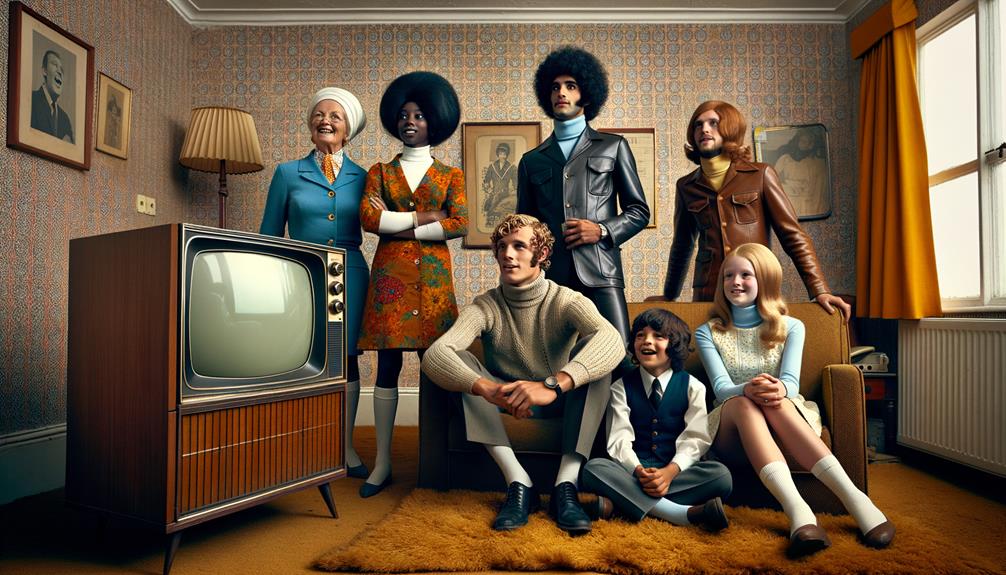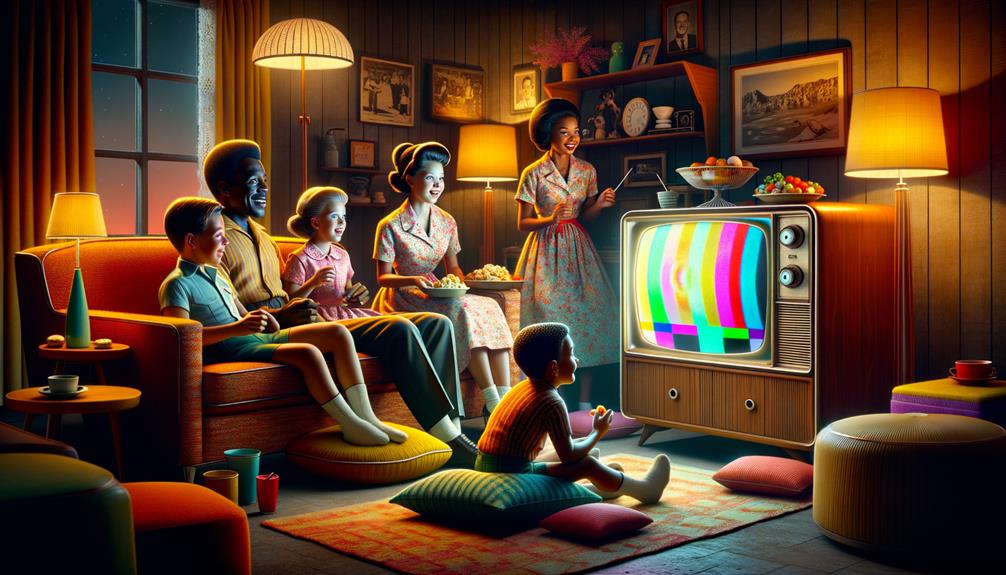
Colour television was officially introduced to the public in the United States on January 1, 1954, following a period of extensive research and development.
Key innovations stemmed from the efforts of pioneers like John Logie Baird in the 1920s and significant advancements made by companies such as RCA and CBS in the 1940s and early 1950s.
The Federal Communications Commission‘s (FCC) approval of RCA’s colour system in 1953 facilitated this launch, setting a standard that would eventually lead to worldwide adoption.
Understanding the trajectory of these technological and regulatory developments offers invaluable insights into the evolution and impact of colour broadcasting.
Quick Summary
- John Logie Baird’s initial experiments in colour television began in 1928.
- The first public colour TV broadcast in the US occurred in 1954.
- RCA released the CT-100, their first colour TV set, in 1954.
- BBC One launched its first colour broadcast in the UK in 1969.
- The FCC approved RCA’s colour system, leading to standardised colour TV in 1953.
- For TV Wall Mounting and cable concealing in all wall types? Fill out the Form Below for instant quotation and same-day/ next-day TV wall mounting service.
Early Demonstrations
In 1928, John Logie Baird pioneered the early demonstrations of colour television by utilising a novel spinning mirror-drum system paired with red-blue filters.
This mechanical scanning method employed spinning mirrors to dissect images, which were then rendered through alternating red and blue filters.
The approach was rudimentary yet ground-breaking, laying the foundational principles for colour broadcasting.
Baird’s method hinged on the synchronised rotation of the mirror-drum, which was critical in the accurate projection of alternating colours.
This system, though not as advanced by modern standards, represented a monumental step forward from the black-and-white images that had previously dominated the visual landscape.
Baird’s experiments underscored the potential for more complex systems, setting the stage for future advancements in television technology.
Baird’s Innovations
Building upon his initial demonstrations, John Logie Baird‘s subsequent innovations in colour television during the 1928-1944 period marked notable advancements in the field, particularly with the introduction of the Telechrome, the first colour picture tube.
Baird’s relentless experimentation underscored his commitment to pushing the boundaries of what was technologically feasible at the time.
His pioneering work not only laid the groundwork for future developments in television technology but also solidified Baird’s legacy as a key figure in the history of broadcasting.
Post-Baird Research

Following John Logie Baird‘s pioneering work, research leadership in colour television shifted considerably to the United States after his death.
This shift marked a significant phase in post-Baird innovations, as American entities like CBS Laboratories and RCA took the helm.
These institutions spearheaded critical research advancements, developing technologies that would define the future of television.
Among these developments was the introduction of the field sequential colour system, which became a cornerstone for early colour TV broadcasts.
This system represented a major technical leap, setting the stage for further enhancements in broadcast technology.
The collaborative efforts of these organisations underscored the dynamic nature of technological evolution in the post-Baird era, driving the television industry towards a vibrant, colour-filled future.
First U.S. Broadcasts
The inaugural public colour television broadcast in the United States occurred in 1954, marking a noteworthy milestone in the evolution of broadcast media.
This event heralded a transformative era in how visual media could influence public perception and cultural trends. Here are key aspects of this innovation:
- Technological Marvel: Introduced advanced technology that greatly enhanced the viewer’s experience.
- Colour TV Impact: Catalysed the development of a vibrant media landscape, influencing advertising, fashion, and entertainment.
- Cultural Significance: Altered everyday life by making visual experiences more engaging and realistic, thereby reshaping cultural norms and expectations.
- Market Expansion: Triggered a rapid increase in consumer demand for colour television sets, boosting the electronics market.
This historic broadcast not only revolutionised television but also had profound societal implications.
UK Colour Launch

How did the launch of colour television on BBC One in 1969 redefine the viewing experience in the UK?
This impactful change marked a significant milestone, enhancing visual storytelling and bringing a new vibrancy to the screen that black and white sets could not offer.
The consumer reaction was overwhelmingly positive, as evidenced by the rapid increase in colour television licences, reaching 11 million by 1978.
This shift was not just technological but deeply cultural, altering how audiences engaged with media and perceived the world around them.
Set against the historical context of the late 1960s, a period rich with social and artistic shifts, the introduction of colour TV became a symbol of modernity and a canvas for broader cultural expression.
Initial Programs
What were the first shows to grace the screens in vivid colour on BBC One’s historic launch day in 1969?
The introduction of colour technology was a monumental advancement in broadcast history, and the initial line-up was meticulously chosen to showcase this innovation:
- An Evening with Petula – A concert by Petula Clark, blending music with colourful visuals.
- Star Trek – The sci-fi series that benefited immensely from the depth and diversity of colour.
- Dixon of Dock Green – A long-running police drama, which gained a new dimension with colour.
- Match of the Day – Football broadcasts that brought the excitement of the game into living rooms with unprecedented vibrancy.
This marked a pivotal moment in television, forever altering viewer expectations and experiences.
Viewing Technology

Advancements in viewing technology, particularly the development of the colour picture tube, revolutionised television by introducing vivid and dynamic visual experiences to audiences worldwide.
The Telechrome, introduced in 1944, marked a pivotal moment in screen technology, enhancing the clarity and vibrancy of images.
This innovation laid the groundwork for subsequent TV innovations, mainly in the United States, where technological leadership shifted post-Baird.
With entities like CBS Laboratories and RCA at the forefront, the enhancement of colour transmission and reception standards became a primary focus.
These developments not only improved the quality of broadcast content but also set the stage for the widespread adoption of colour television, beginning with the inaugural public service in the USA in 1954.
Evolution of Colour TV
Building on the foundational innovations of the Telechrome and other early technologies, the evolution of colour TV during the mid-20th century marked a transformative era in broadcasting and consumer electronics.
This period in the innovation timeline was characterised by significant advancements and a noticeable shift in consumer preferences towards colour broadcasting.
Key developments included:
- 1954 Introduction in the USA: The launch of regular colour broadcasts set a new standard in television viewing.
- 1967 Expansion in the UK: The BBC2’s adoption of colour for the Wimbledon championships broadened colour TV’s appeal.
- 1969 Technological Advancement: Sony’s Trinitron tube enhanced colour accuracy and brightness.
- Shift in Market Dynamics: By the 1970s, colour TVs began to dominate the market, reflecting a clear preference among consumers for richer, more engaging viewing experiences.
Global Adoption

The global adoption of colour television, following its debut in the United States in 1954, saw varying rates of uptake in different countries, influenced by technological, economic, and regulatory factors.
This expansion had a profound global impact, reshaping entertainment and media landscapes.
By the late 1970s, significant market penetration was evident in the UK, with 11 million colour TV licenses issued.
Other nations such as Australia, Austria, and Canada embraced this technology throughout the 1960s and 1970s, highlighting the broad cultural significance and demand for enhanced viewing experiences.
Technological Advances
Technological innovations in the mid-20th century greatly hastened the development and adoption of colour television, beginning particularly with John Logie Baird’s pioneering Telechrome system in 1940.
The advancements in display technology and the standardisation of systems marked significant milestones in television history.
Here are a few key developments:
- RCA vs. CBS Demonstrations: Competing demonstrations to the FCC highlighted the viability of colour broadcasting.
- RCA’s Dot-Sequencing: Approved by the FCC in 1952, this method became the industry standard.
- Release of the CT-100: In 1954, RCA launched the first mass-produced colour TV set, influencing global markets.
- NTSC Standardisation: Adoption of RCA’s system in 1952 ensured a consistent approach to colour television transmission and reception.
Frequently Asked Questions
When Did Colour TV Come to the UK?
Colour TV was introduced in the UK on November 15, 1969, marking a pivotal shift in broadcasting standards and accelerating technological adoption in media consumption across the region.
When Was Colour TV Widely Available?
Colour TV was widely available by the mid-1960s, marking a pivotal moment in broadcasting evolution. The rapid consumer adoption during this period greatly transformed television viewing experiences across various markets globally.
When Did We Go to Colour TV?
The shift to colour TV involved overcoming technological challenges and fostering consumer adoption. Initially introduced in 1954 in the USA, widespread acceptance and usage grew markedly by the late 1960s and early 1970s.
What Were the First TV Shows in Colour?
The initial TV shows in colour, marking colourful advancements and technological milestones, included NBC’s ‘Premiere’ in 1953, followed by ‘Colgate Comedy Hour’ and ‘Kukla, Fran and Ollie’ in 1954.
Conclusion
To sum up, the evolution of colour television from its conceptual demonstrations to global adoption represents a significant technological advancement in media history.
The journey involved substantial research and innovation, spearheaded by pioneers like John Logie Baird and propelled forward through various technological leaps.
This progression not only revolutionised the viewing experience by enhancing visual realism but also set the stage for further innovations in broadcasting and display technologies, fundamentally altering how information and entertainment are consumed worldwide.
